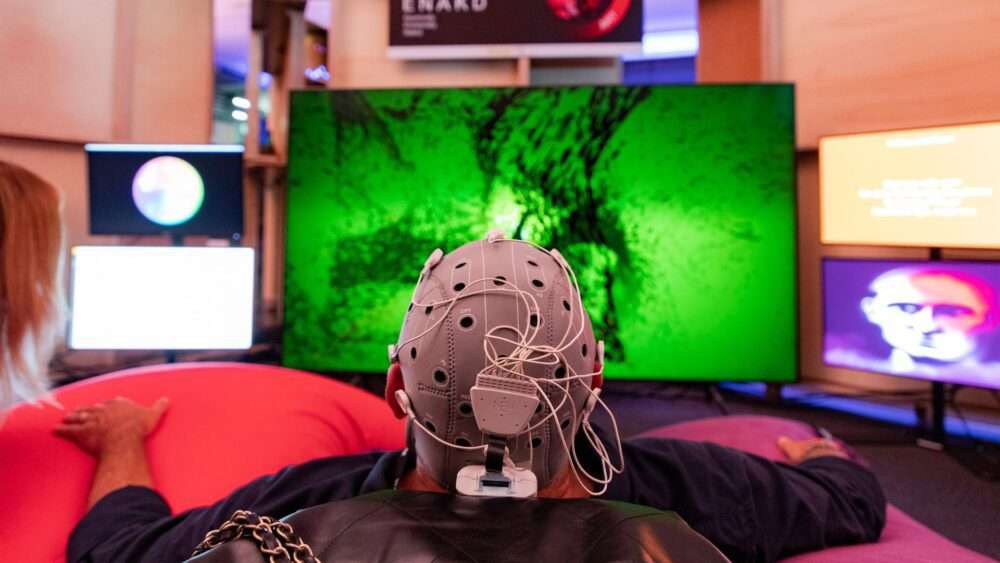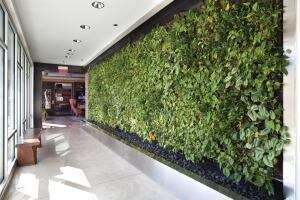Sónar+D 2023: a journey into the future of creativity
Sónar+D 2023: a journey into the future of creativity
At Sónar+D, you might encounter an influential thinker engaged in a talk about the impact of AI on the creative industry; nearby, others are presenting their latest models of modular synthesizers. A visionary scientist from a university research center exhibits a machine that transmutes particles from exploding stars into captivating melodies.
An artist is presenting an app that estimates the CO2 emissions generated by your recently shared Instagram photos. Further along, an immersive olfactory experience awaits discovery. Countless VR headsets invite visitors to explore a myriad of surreal worlds, and an augmented reality installation by Aphex Twin makes every visitor stop by for a picture. The environment is a testament to Sónar+D’s invigorating cross-pollination of creativity, technology, and music.
Through its eclectic array of talks, presentations, exhibitions, performances, and conversations, Sónar+D fosters an environment that both stimulates the intellect and inspires the creative spirit. Since its inception in 2013, the festival has served as a channel for avant-garde ideas and groundbreaking technologies, ultimately propelling our collective vision toward an exciting future.

Following the conclusion of Sónar+D 2023, I had the chance to interview Antònia Folguera, curator of the festival, on a variety of compelling topics including the transformative influence of the festival, the potential of Artificial Intelligence in the creative sector, the gradual evolution of immersive technologies, and the urgency of climate change awareness within the digital art and culture community.
Her insights offer a rich exploration of the symbiotic relationship between creativity and technology, revealing how the fusion of these domains continually shapes our present and projects new futures.

I have some questions for you. Firstly, as the curator of Sónar+D, could you elaborate on the vision behind this year’s event and its evolution from previous years?
Antònia Folguera:
“Sónar+D’s vision builds upon what we’ve accomplished in previous years, all the way back to 1994, the year the festival was born. The initial model of the festival was not merely a music festival, but an event that encapsulated a wide range of experiences about the cultural zeitgeist. For instance, the internet was a primary topic in its early years as it was still quite new. Now, our focus has shifted toward artificial intelligence.
Sónar+D is more than a music festival; it’s a collection of cultural experiences. We aim to blend different aspects of today’s culture into the festival: music, talks, workshops, roundtables, networking activities, project presentations, and exhibitions. The exhibitions include a mixture of art products, prototypes, and projects that defy classification, including selections of virtual reality and augmented reality.
We see Sónar+D as an event that connects the Sónar Music Festival with other realms, whether it be technology, art, science, design, or even philosophy. Moreover, We particularly enjoy featuring multidimensional participants—not simply musicians or designers but individuals who bridge different disciplines. We pride ourselves on being an anti-disciplinary event, exploring the spaces that exist on the borders of traditional disciplines.”

So, the focus is not strictly on categorization, but rather the unique space formed by overlapping disciplines?
Antònia Folguera:
“Correct. The ability to feature a range of talents—such as a researcher like Kate Darling, a musician/thinker like Kode9, a writer on technology and culture like Claire L. Evans, and Richie Hawtin with his modular synth for teaching music to young audiences—all in one program is what we strive for.
Our goal is to create a cohesive, meaningful event that spans generations, levels of expertise, and career stages, from established artists to emerging talents.”
It certainly sounds exciting. Could you elaborate on the role of Sónar+D in pioneering unconventional themes in art, science, and digital culture? How does the festival catalyze connections that lead to influential projects?
Antònia Folguera:
“Sónar+D often introduces topics or projects that may initially seem unconventional but eventually become mainstream. For instance, we started discussing artificial intelligence in 2016, a time when it was largely considered a subject for science fiction or academia. Over time, we’ve seen this topic become increasingly mainstream.
Moreover, we’ve seen various projects born within the festival due to the connections made there. Sometimes we help initiate these collaborations, and it’s always gratifying when these projects take on a life of their own. While it’s impossible to predict what will come from these collaborations, their potential to grow and impact various sectors makes Sónar+D all the more exciting.”

Shifting to the main theme you’ve been working on this year – artificial intelligence, a topic also widely discussed in design – I’m interested in your perspective on how AI is revolutionizing creativity. What impact is it having on creative production?
Antònia Folguera:
“In my view, it’s a process. Back in 2017, we invited artists like Memo Akten and Mario Klingemann, who were already experimenting with accessible machine-learning applications. While exploring the aesthetic possibilities of artificial intelligence, they were also questioning the potential impact of AI on creativity. One such project was “My Artificial Muse” by Mario Klingemann and Albert Barqué-Duran, which highlighted the biases in machine learning algorithms. This was an early indicator of where technology was heading and how artists perceived it.
More recently, numerous artists have been reflecting on artificial intelligence, utilizing AI tools to explore its capabilities, dilemmas, and the societal, ethical, and political implications it represents. I believe there will be a point where the conversation evolves and these tools will be used to discover and explore other artistic languages. Artists have always pushed the boundaries of technology to see where it can go, and we’re privileged enough to observe this process and its evolution year after year. It’s been especially fast-paced over the last year and a half.”
What benefits can designers gain from participating in Sónar+D?
Antònia Folguera:
“Primarily, designers become part of a cultural experience that we hope is inspiring. Designers need to stay current with technologies, aesthetic trends, and fresh ideas relevant to their work. Attending the event offers the opportunity to encounter other designers from various fields, such as graphic design, product design, and industrial design.
The main takeaway would be inspiration and the chance to connect with diverse communities, each with its own culture and aesthetics, which can be useful for designers.”

You mentioned communities, which ones are you referring to?
Antònia Folguera:
“I’m referring to communities ranging from music to technology. For instance, there are the DIY enthusiasts, the AI enthusiasts, those into generative and algorithmic art, and those more focused on hardware. Take the design of a modular synthesizer as an example; not only is the sound important but also the placement of buttons and the overall shape. This can certainly inspire.”
You mentioned an anti-disciplinary approach, which seems to resonate with designers. Could you expand on that?
Antònia Folguera:
“By an anti-disciplinary approach, I mean a space that merges multiple tech skills and interests. Many designers fit into this space, which is well-defined and has its entity. An example of someone embodying this approach is artist Daito Manabe. Trained as a mathematician, he’s proficient in computer programming, visual design, and music, and has a distinct aesthetic.
His team is capable of bringing innovative ideas to fruition, and their work is highly appealing. We’ve featured Daito and his team numerous times at our festival, presenting everything from performances and installations to dance pieces, talks, and workshops. In my view, we should feature more artists of this kind as much as we can.”

Could you point out some emerging technologies or trends within the areas of creativity, art, and technology that you believe are worth keeping an eye on in the current stage?
Antònia Folguera:
“Certainly, there are a couple that stands out to me. The first would be quantum technology. It’s complex and not easy to comprehend, but quantum computers are already a reality. While we may not have quantum computers in our homes anytime soon, they are already starting to influence the artistic and musical fields. The non-binary logic of quantum computing – where values aren’t just 0 or 1, but can be both simultaneously – opens up new aesthetic possibilities and novel ways of connecting ideas. We’ve covered quantum computing at the festival and even held a masterclass exploring it through the lens of music.
Another area to monitor is immersive technology, including virtual reality (VR), augmented reality (AR), and spatial computing. The mainstream impact of these technologies hasn’t fully materialized yet, but many creatives are experimenting with these platforms to create narratives and experiences. It feels like we’re nearing a point where everything will start to make sense for the general audience, much as it happened with artificial intelligence.
It’s important to remember that sometimes the knowledge isn’t ready, or society isn’t ready for new technologies. AI, for instance, was launched around 70 years ago and there was a major boom in the 80s with companies investing heavily, but it failed to meet expectations likely due to lack of computational power. But look at the world now, AI has become central to many areas. I believe something similar will happen with virtual and spatial reality technologies, which could have significant implications for artists and designers.”

As we look to the future and the next year, what directions do you anticipate Sónar+D will take?
Antònia Folguera:
“It’s still a bit early to know for certain. We do have a wishlist that grows over time. As we constantly encounter interesting things, many ideas are put on a “bucket list” when we run out of time or space in programming. We like to think of Sónar+D as an evolving entity that takes different shapes and remains receptive to creators’ proposals.
Artificial Intelligence will remain a major focus, as will topics related to the climate emergency, which is increasingly becoming a central theme for creators and artists. As always, we will continue to highlight intriguing projects that bridge various disciplines.”
Before we conclude, how can people remain engaged with Sónar+D activities before the next event?
Antònia Folguera:
“Certainly, there are a few things in the works that I can’t reveal just yet. However, we will be celebrating the 30th anniversary, and we anticipate there will be some exciting developments by the end of the year that should engage the Sónar+D audience and beyond.
The best way to stay updated on these developments is through our social media platforms, particularly our Twitter account, where we share updates about our activities, open calls, and other relevant content. Additionally, subscribing to our newsletter, while somewhat old-school, is another reliable method of staying informed.”

Finally, Read more on Archup:







